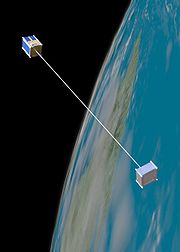
Tempo3
Encyclopedia

CubeSat
A CubeSat is a type of miniaturized satellite for space research that usually has a volume of exactly one liter , has a mass of no more than 1.33 kilograms, and typically uses commercial off-the-shelf electronics components...
-based
satellite
Satellite
In the context of spaceflight, a satellite is an object which has been placed into orbit by human endeavour. Such objects are sometimes called artificial satellites to distinguish them from natural satellites such as the Moon....
meant to demonstrate artificial gravity generation. After launch, the spacecraft will spin end over end to create gravity-like acceleration at both ends of a tether. The project is being run by the Mars Society
Mars Society
The Mars Society is an international space advocacy non-profit organization dedicated to promoting the human exploration and settlement of the planet Mars. It was founded by Robert Zubrin and others in 1998 and attracted the support of notable science fiction writers and filmmakers, including Kim...
, and will build from high-altitude tests to eventual orbital flight in 2011.
Background
In the Mars DirectMars Direct
Mars Direct is a proposal for a manned mission to Mars. Proponents of the scheme have claimed it to be both cost-effective and that it can be conducted with current technology. It was originally detailed in a research paper by NASA engineers Robert Zubrin and David Baker in 1990, and later expanded...
architecture for a humans-to-Mars mission, the crew on their way to Mars
Mars
Mars is the fourth planet from the Sun in the Solar System. The planet is named after the Roman god of war, Mars. It is often described as the "Red Planet", as the iron oxide prevalent on its surface gives it a reddish appearance...
uses their discarded upper stage as a counterweight to spin end over end. This action generates gravity for the crew and prevents them from having to spend the six month trip in zero-gravity conditions. Gemini 11
Gemini 11
Gemini 11 was the ninth manned spaceflight mission of NASA's Project Gemini, which flew from September 12 to 15, 1966. It was the 17th manned American flight and the 25th spaceflight to that time . Astronauts Charles "Pete" Conrad, Jr. and Richard F. Gordon, Jr...
and 12
Gemini 12
-Backup crew:-Mission parameters:*Mass: *Perigee: *Apogee: *Inclination: 28.87°*Period: 88.87 min-Docking:*Docked: November 12, 1966 - 01:06:00 UTC*Undocked: November 13, 1966 - 20:18:00 UTC-Space walk:...
showed that the concept was viable, but no gravity-related work has taken place since then using tethers.
TEMPO³ was selected as the winner of the Mars Project Challenge, run by the Mars Society
Mars Society
The Mars Society is an international space advocacy non-profit organization dedicated to promoting the human exploration and settlement of the planet Mars. It was founded by Robert Zubrin and others in 1998 and attracted the support of notable science fiction writers and filmmakers, including Kim...
in 2008, to determine the group's next major project.
Mission concept
The spacecraft will launch with other CubeSatCubeSat
A CubeSat is a type of miniaturized satellite for space research that usually has a volume of exactly one liter , has a mass of no more than 1.33 kilograms, and typically uses commercial off-the-shelf electronics components...
satellites. After separating from its carrier, TEMPO³ will spin up and then split into two parts connected by a tether.
Separating will slow the spin rate, but will increase the acceleration measured at the ends. Accelerometers on board the spacecraft will sense the amount of gravity being demonstrated and will beam that data to Earth.

